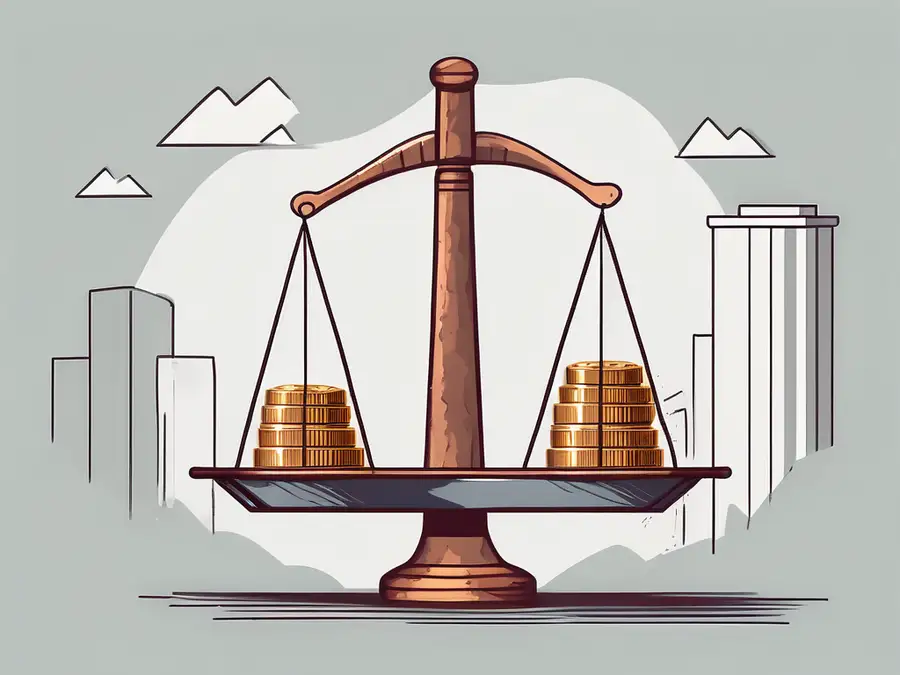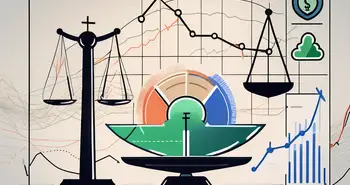Understanding the Importance of Risk Capital in Investment

Investing can be a thrilling and potentially lucrative venture, but it also carries a significant amount of risk. That's where risk capital comes into play. In this article, we will delve into the world of risk capital and explore its crucial role in investment. By understanding the concept of risk capital and its impact on financial markets, you will be better equipped to navigate the complexities of investing.
Defining Risk Capital
At its core, risk capital refers to the amount of money that an investor is willing to put at stake in the pursuit of potentially higher returns. This capital is typically allocated to high-risk investments, such as start-ups or ventures with uncertain outcomes. Unlike traditional investment funds, risk capital is not expected to generate immediate or guaranteed returns.
However, risk capital is not just a financial concept; it embodies the spirit of entrepreneurship and innovation. It represents the willingness to take calculated risks and invest in unproven or risky ventures. Risk capital is the lifeblood of emerging industries and fuels the growth of companies that have the potential to disrupt existing markets.
When individuals or organizations invest risk capital, they are demonstrating their belief in the potential success of an idea, even if the odds are stacked against it. This belief is often driven by a combination of market research, industry knowledge, and a gut feeling that the investment will pay off in the long run.
The Concept of Risk Capital
Risk capital plays a crucial role in driving innovation and progress. It provides financial support to entrepreneurs and visionaries who dare to challenge the status quo. These individuals are driven by a desire to create something new, to solve problems, and to make a lasting impact on society.
By investing risk capital, individuals or organizations become partners in the journey of these entrepreneurs. They share in the excitement, the uncertainty, and the potential rewards. They understand that not every investment will be a success, but they are willing to take the risk because they believe in the power of ideas and the ability of passionate individuals to turn those ideas into reality.
Moreover, risk capital is not limited to a specific industry or sector. It can be found in technology start-ups, biotech research, renewable energy projects, and even artistic endeavors. It is a driving force behind the development of new products, services, and solutions that have the potential to reshape our world.
Differentiating Risk Capital from Other Investment Terms
While risk capital shares similarities with other investment terms, such as venture capital or angel investing, it has distinct differences that set it apart.
Risk capital encompasses a broader range of investments, including personal funds used by individuals to finance their own ventures. It represents the personal commitment and belief of an individual in their own ideas and abilities. This form of risk capital is often seen in small business owners who invest their savings or take out loans to start their own companies.
Venture capital, on the other hand, involves investing in external companies, typically in exchange for equity ownership or a stake in future profits. Venture capitalists are professional investors who provide funding to start-ups or early-stage companies that show high growth potential. They bring not only capital but also expertise, industry connections, and guidance to help the companies succeed.
Angel investing is another form of risk capital that focuses on early-stage investments in start-ups. Angel investors are typically high-net-worth individuals who provide financial support to entrepreneurs in exchange for equity or convertible debt. They often play a mentorship role, leveraging their experience and networks to help the start-ups navigate the challenges of building a successful business.
While risk capital, venture capital, and angel investing all involve taking risks and investing in high-potential ventures, they differ in terms of the source of capital, the stage of investment, and the level of involvement in the company's operations.
The Role of Risk Capital in Investment
Risk capital plays a crucial role in investment, acting as a catalyst for innovation, economic growth, and job creation. Without risk capital, many groundbreaking ideas and ventures would never come to fruition due to the lack of financial support. It is the fuel that propels disruptive technologies and enables entrepreneurs to take calculated risks in pursuit of their visions.
Risk Capital as a Safety Net
Risk capital serves as a safety net for entrepreneurs and investors alike. By allocating a portion of their capital toward high-risk investments, individuals can safeguard their principal assets and mitigate potential losses. This diversification strategy allows them to participate in ventures that have the potential for substantial returns while minimizing the overall risk to their investment portfolio.
Risk Capital and Investment Strategies
For seasoned investors, risk capital serves as a critical component of their overall investment strategy. By carefully assessing the risk-reward ratios of various investment opportunities, they allocate the appropriate amount of risk capital to ventures that align with their financial goals and risk tolerance. This strategic approach helps investors make informed decisions and increases their chances of generating positive returns in the long run.
Evaluating the Amount of Risk Capital
When determining the appropriate amount of risk capital to allocate, several factors come into play.
Factors Influencing Risk Capital
Factors such as personal financial standing, investment knowledge, risk appetite, and investment timeframe all impact the amount of risk capital one is willing to deploy. For example, someone with a higher risk tolerance and a longer investment horizon may allocate a larger portion of their capital to riskier assets compared to a conservative investor with a shorter time frame.
Calculating Your Risk Capital
To calculate the amount of risk capital to allocate, it is essential to assess your total investable assets, your financial obligations, and your willingness to bear potential losses. A general rule of thumb is to allocate a portion of your capital that you can afford to lose entirely without jeopardizing your financial well-being or long-term goals. By diversifying your risk capital across a range of investments, you can further mitigate potential losses and maximize your chances of reaping rewards.
Risk Capital and Portfolio Diversification
One of the key considerations when investing risk capital is portfolio diversification.
The Relationship Between Risk Capital and Diversification
Diversification is the practice of spreading one's investments across a variety of asset classes and industries to reduce exposure to any single investment or risk. Risk capital plays a critical role in this strategy, as it allows investors to allocate a portion of their capital to high-risk, high-reward ventures while keeping the majority invested in more stable and diversified assets. This balanced approach helps safeguard against the potential pitfalls of concentrated investments and increases the likelihood of overall portfolio growth.
Balancing Risk Capital with Diversified Investments
Successful investment strategies strike a balance between risk capital and diversified investments. By carefully selecting a mix of low-risk and high-risk assets, investors can achieve optimal risk-adjusted returns. Diversification acts as a cushion, reducing the impact of any potential losses incurred through risk capital while maintaining the potential for substantial gains through successful high-risk investments.
The Impact of Risk Capital on Financial Markets
Risk capital does not exist in isolation; it has a profound impact on financial markets and drives market trends.
Risk Capital and Market Volatility
Market volatility is influenced by risk capital, as investors' willingness to take on risk affects market sentiment and asset prices. When risk capital flows into the markets, it often fuels asset bubbles or speculative frenzies, leading to increased volatility. Conversely, a retreat of risk capital can trigger market corrections or downturns as investors become more risk-averse.
The Influence of Risk Capital on Market Trends
Risk capital plays a significant role in shaping market trends. As investors seek opportunities with higher return potential, the influx of risk capital into specific sectors or industries can fuel their growth. This influx can lead to a self-reinforcing cycle where increased investment attracts more capital and drives further expansion. Conversely, a decline in risk capital can result in a market contraction as funding for projects and innovation dwindles.
As an expert in the field, I have witnessed the transformative power of risk capital firsthand. One personal story that stands out to me is the success of a start-up I invested risk capital in. While the odds were against us, the bold vision and dedication of the founders, coupled with the financial support provided by risk capital, allowed the company to thrive and eventually become a market leader. This experience reaffirmed my belief in the importance of risk capital and its ability to fuel innovation and drive economic growth.
FAQ
1. What is risk capital?
Risk capital refers to the amount of money an investor is willing to put at stake in high-risk investments with uncertain outcomes.
2. How does risk capital impact investment strategies?
Risk capital is a critical component of an investment strategy, allowing investors to allocate funds to high-risk ventures that align with their financial goals and risk tolerance.
3. What is the relationship between risk capital and portfolio diversification?
Risk capital and portfolio diversification go hand in hand. Risk capital allows investors to invest in high-risk ventures while keeping the majority of their funds allocated to diversified assets, reducing overall risk exposure.
4. How does risk capital influence financial markets?
Risk capital drives market trends and impacts market volatility. The inflow or outflow of risk capital can lead to asset bubbles, market corrections, or contractions.
By understanding the importance of risk capital in investment, investors can make informed decisions and seize opportunities in the world of high-risk, high-reward ventures. Balancing risk capital with diversified investments and carefully evaluating the appropriate amount to allocate are essential considerations for those seeking to maximize their investment returns while managing risk. As an expert in the field, I encourage you to embrace risk capital as a powerful tool in your investment journey.
Ready to take control of your investment journey with risk capital? Discover Morpher, the revolutionary trading platform that's changing the game with blockchain technology. At Morpher, you can trade across a multitude of asset classes, from stocks and crypto to the most unconventional markets, all with zero fees and infinite liquidity. Embrace the power of fractional investing, short selling, and up to 10x leverage to maximize your investment potential, while enjoying the safety and control of the Morpher Wallet. Join a community of forward-thinking investors on a platform that's as innovative as your investment strategy. Sign Up and Get Your Free Sign Up Bonus today, and start trading on a platform that's as dynamic and diverse as the world of risk capital itself.

Disclaimer: All investments involve risk, and the past performance of a security, industry, sector, market, financial product, trading strategy, or individual’s trading does not guarantee future results or returns. Investors are fully responsible for any investment decisions they make. Such decisions should be based solely on an evaluation of their financial circumstances, investment objectives, risk tolerance, and liquidity needs. This post does not constitute investment advice.

Painless trading for everyone
Hundreds of markets all in one place - Apple, Bitcoin, Gold, Watches, NFTs, Sneakers and so much more.

Painless trading for everyone
Hundreds of markets all in one place - Apple, Bitcoin, Gold, Watches, NFTs, Sneakers and so much more.









